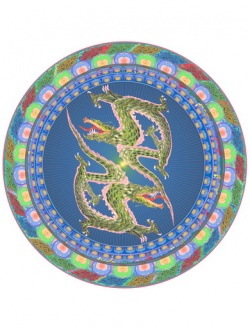Difference between revisions of "Chakravarti-raja"
(Created page with "thumb|250px| <poem> wheel-turning king (Skt chakravarti-raja ) </poem> {{E}} {{SanskritTerminology}}") |
|||
| Line 3: | Line 3: | ||
[[wheel-turning king]] (Skt [[chakravarti-raja]] ) | [[wheel-turning king]] (Skt [[chakravarti-raja]] ) | ||
| + | |||
| + | [[wheel-turning king]] | ||
| + | [[転輪聖王]]・[[転輪王・輪王]] (Skt [[chakravarti-raja]], [[chakravarti-rajan]], or [[chakravartin]]; Jpn [[tenrin-jo’o]], [[tenrin-o]], [[or rin-o]] ) | ||
| + | |||
| + | Also, [[wheel-turning sage king]], or [[wheel-king]]. An [[ideal ruler]] in {{Wiki|ancient Indian}} [[mythology]] who governs with justice rather than force and brings [[tranquillity]] and {{Wiki|comfort}} to the [[people]]. He possesses [[seven treasures]]: [[a wheel]], [[elephants]], [[horses]], [[jewels]], [[jewel-like women]], [[excellent ministers]] of financial affairs, and [[generals]]. He also possesses the [[thirty-two features]] as a [[Buddha]] does, as well as the [[four virtues of great wealth]], admirable features and [[form]], freedom from worries, and long [[life]]. According to some [[scriptures]], when [[Shakyamuni]] was born, a [[hermit-sage]] named [[Asita]] foretold that, if the boy remained in the {{Wiki|secular}} [[world]], he would become [[a wheel-turning king]], but if he renounced {{Wiki|secular}} [[life]], he would become a [[Buddha]]. | ||
| + | |||
| + | While [[turning the wheel]] he was given by [[heaven]], a [[wheel-turning king]] advances everywhere at will and establishes [[peace]]. These wheels are of four kinds: {{Wiki|gold}}, {{Wiki|silver}}, {{Wiki|copper}}, and {{Wiki|iron}}, the type of [[wheel]] indicating a [[wheel-turning king's]] rank, or the extent of his [[realm]] and power. A [[gold-wheel-turning king]] rules all the [[four continents]] surrounding [[Mount Sumeru]]; a [[silver-wheel-turning king]], the eastern, {{Wiki|western}}, and southern continents; a [[copper-wheel-turning king]], the eastern and southern continents; and an [[iron-wheel-turning king]], the southern continent, or [[Jambudvipa]]. [[Buddhist scriptures]] contain stories of [[Shakyamuni Buddha's]] previous [[incarnations]] as a [[wheel-turning king]]. | ||
| + | |||
</poem> | </poem> | ||
{{E}} | {{E}} | ||
{{SanskritTerminology}} | {{SanskritTerminology}} | ||
Revision as of 04:42, 16 February 2014
wheel-turning king (Skt chakravarti-raja )
wheel-turning king
転輪聖王・転輪王・輪王 (Skt chakravarti-raja, chakravarti-rajan, or chakravartin; Jpn tenrin-jo’o, tenrin-o, or rin-o )
Also, wheel-turning sage king, or wheel-king. An ideal ruler in ancient Indian mythology who governs with justice rather than force and brings tranquillity and comfort to the people. He possesses seven treasures: a wheel, elephants, horses, jewels, jewel-like women, excellent ministers of financial affairs, and generals. He also possesses the thirty-two features as a Buddha does, as well as the four virtues of great wealth, admirable features and form, freedom from worries, and long life. According to some scriptures, when Shakyamuni was born, a hermit-sage named Asita foretold that, if the boy remained in the secular world, he would become a wheel-turning king, but if he renounced secular life, he would become a Buddha.
While turning the wheel he was given by heaven, a wheel-turning king advances everywhere at will and establishes peace. These wheels are of four kinds: gold, silver, copper, and iron, the type of wheel indicating a wheel-turning king's rank, or the extent of his realm and power. A gold-wheel-turning king rules all the four continents surrounding Mount Sumeru; a silver-wheel-turning king, the eastern, western, and southern continents; a copper-wheel-turning king, the eastern and southern continents; and an iron-wheel-turning king, the southern continent, or Jambudvipa. Buddhist scriptures contain stories of Shakyamuni Buddha's previous incarnations as a wheel-turning king.
